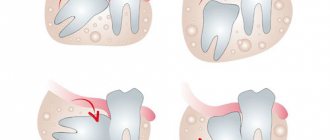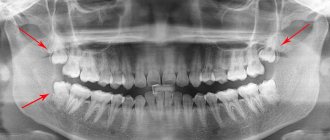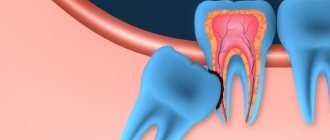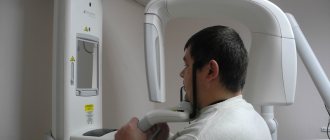Going to the dentist is always stressful for the patient. The main problem and fear before removal is pain. Modern technologies allow for painless removal, but this does not relieve patients from worrying about this problem. The wisdom tooth is rightfully considered one of the most difficult to remove, and therefore its painless removal is a real breakthrough in the field of dentistry. Specialists at the Zuub clinic perform wisdom tooth removal quickly, competently and without any pain.
Is it painful to remove a wisdom tooth from above?
The bone tissue of the upper jaw is not as dense as the tissue of the lower jaw. Additionally, superior figure eights typically have less tortuous roots than lower molars. Therefore, local anesthesia can completely relieve the patient of pain during surgery. This is confirmed by reviews of people who have already had an upper wisdom tooth pulled out. They note that the most unpleasant, but quite tolerable sensations were experienced when the anesthetic was administered. And the removal itself was absolutely painless.
It can really hurt those patients who put off visiting the doctor for a long time. And all this time they took painkillers. Local anesthesia also has a very bad effect on people who use drugs.
Stages of the surgical procedure
Before the procedure, a consultation is carried out and the necessary X-ray diagnostics are prescribed.
After which the doctor begins the actual removal:
- First, an anesthetic is injected.
- If the eighth tooth has not fully erupted, a small incision is made in the gum to access it.
- After this, the tooth is removed using an elevator.
- The gum is sutured.
If the tooth is completely under the bone, a larger incision is made in the gum, and in order to extract the dental unit, it is cut into several parts.
Removing a cyst is a highly complex procedure. The mucous membrane is cut, bone tissue is removed with special burs, after which the cyst is removed. Next, in order to avoid relapse, the root tip is removed.
Is it painful to remove a wisdom tooth from below?
Reviews about the removal of lower wisdom teeth are very contradictory. Some talk about the complete painlessness of the operation, others remember the minutes spent in the chair with a shudder. The fact is that when a wisdom tooth is removed from below, the patient’s sensations directly depend on the professionalism of the doctor.
Thus, infiltration anesthesia in the upper jaw is carried out in the gum in the area of the root of the wisdom tooth. And in the case of the lower “eight”, the dentist has to give an injection from the inside of the jaw. Carrying out such anesthesia is technically more difficult, and, alas, not all dentists are fluent in it.
If modern anesthetics are used, and the doctor is a professional in his field, pain during the removal of the lower wisdom tooth is completely eliminated.
It may hurt a little when the anesthetic is administered. Unpleasant sensations do not go away if an abscess has already formed in the area of the wisdom tooth. But in particularly difficult cases, the dentist may decide to use general anesthesia.
Estimated cost of the procedure
According to the compulsory medical insurance policy, a tooth can be removed completely free of charge, in a state clinic. In private clinics, the procedure will cost from 1,500 to 3,000 rubles, depending on the degree of complexity. In some situations, the cost of the operation can even reach 15 thousand rubles or more, for example, with a complex extraction of the figure eight using sedation.
As for immediate recovery, the cost of such treatment using inexpensive brands will cost approximately 30-50 thousand rubles - this includes x-ray diagnostics, 3D planning and tests. Restoration with the installation of a more expensive Nobel Biocare implant and an adaptation crown will cost approximately 70-90 thousand rubles.
- Drobyshev A.Yu., Matytsin O.M., Dronov M.V. Modern approaches to immediate dental implantation, 2004.
Patient reviews
Review 1
Before describing the procedure, I want to talk about my pain threshold. I can NOT stand pain. At all! I LOVE IT!!! For example, before treating caries, I ask you to give me 2 painkiller injections. And then one day my wisdom tooth began to hurt. I endured it steadfastly! But patience has come to an end! I had to go to the clinic.
Sitting down in a chair, I, as usual, asked for 2 injections and mentally prepared myself for torture :) Instead of somehow supporting and encouraging me, the doctor said: - Nahhh... but the tooth is in an inaccessible place! You can’t even get close to him!!!
Then she asked me to open it wider, then even wider, then again and again... It seemed to me that the corners of my mouth were already torn, and the doctor kept asking me to make my “mouth wider”! At the same time, she said, “What can I do here...” and tried to pick up the tooth with pliers.. These attempts lasted about 5 minutes. There was no particular pain, it was just unpleasant that the doctor could not pick up the tooth and was scared from waiting for the outcome. In the end, I asked: - Maybe I’ll go already?!!! If she can’t pick up a tooth, then WHAT will happen next?! To my deep surprise, the doctor did not even try to persuade me to stay and complete the procedure. She simply said: “Go!”
Well, wow :) This has never happened to me before. Usually doctors persuade: - Well, be patient... If you came, then you need to be patient. And here on you - go... I ask: - And what to do now? The answer was: “Nothing!” Rinse! And don't eat anything for 2 hours. And don't drink anything hot all day. - Why??? - Because the wound should heal. - So you REMOVED my tooth??? - Yes!
Just like that! While I was preparing for “medieval torture” and many hours of torment, the specialist did her job! BRAVO!!! I was delighted! After a couple of hours, the freezing sensation began to subside and the pain returned. She was tolerable, rinsing helped. After a few days the pain went away, but the wound healed for probably a whole month! The pain was weak and dull... The gums ached a little and as if something was pulling. But everything ended well! Everything is overgrown evenly.
Review 2
One of the four teeth had grown into the gum and began to rot there. Therefore, when I came to my favorite dentist, there was only one diagnosis - the wisdom tooth needed to be removed. I honestly couldn’t even get scared when I was already given anesthesia and the fragile dentist started pulling my tooth.
From the sensations, I can’t say that it hurt, no, the anesthesia worked well, but there was a feeling, I felt the tooth being taken with forceps, how it was being pulled, and I was even surprised how my fragile doctor pulled out this chunky tooth. He fought hard to get out, but for professionals there are no problems.
After this, of course, my gums bled a little, I was prescribed mouth rinses so that everything would heal faster. My gums healed within a day. I did not feel any discomfort due to the missing wisdom tooth.
Therefore, I can say for sure that the devil is not as scary as he is painted. Yes, it was unpleasant, but not painful and it could be tolerated. And if I have to remove the rest of my wisdom teeth, I won’t be the least bit upset or scared. Since there is nothing scary in this procedure.
Why don’t everyone develop eights?
No, not because someone is wise and someone is not so wise. Let's start with the fact that the absence of third molar rudiments from birth is very rare. But not everyone has them. There may be several reasons for this:
- Design features of the jaw . Due to the fact that eights begin to climb at a time when the dentition is already fully completed, they simply have nowhere to squeeze in.
- Genetic predisposition . There is a theory that if you have painful teething or removal of eights in your family, they may not grow.
| According to statistics, 92% of people have all four eights. Of these, in 25% they do not erupt. 8% of humanity does not have third molars even in their embryonic state. And 0.1% of the adult population has a superset - more than four “wise” teeth. |
How long will an extracted tooth hurt?
Removing a wisdom tooth is a serious surgical procedure that severely injures the soft tissues of the periodontium. The fact is that third molars are large teeth, having from 2 to 5 roots. And after their removal, an open bleeding wound remains in the jawbone and gum, which will definitely hurt. And not a couple of hours, but several days.
The pain can be aching and cutting, radiating to the throat or ear. The patient may complain of painful swallowing and persistent headache. An increase in body temperature to 37.5 0C is also natural and physiological. There is no need to endure unpleasant sensations. After tooth extraction, the dentist will definitely recommend painkillers:
- paracetamol;
- ibuprofen;
- analgin;
- butadione;
- sedalgin.
All of them are available without a prescription, are not addictive and have minimal side effects. At the same time, they effectively relieve pain. Normally, the pain at the site of the extracted tooth subsides within 3-7 days. And the final healing of the hole occurs by the end of 2 - 3 weeks after tooth extraction. During this time, she needs to be protected from injury - brush her teeth carefully, eat food carefully.
The appearance of edema is also natural after the removal of the figure eight. As a rule, it forms during the first day after surgery and lasts for the next 2 to 3 days.
If over time the pain does not subside, but, on the contrary, intensifies, you should immediately consult a doctor. Alarm signals are a strong increase in temperature, an unpleasant odor from the hole, acute pain radiating to the temple or ear. These symptoms may indicate the development of inflammation. And without the intervention of a dentist, the purulent process will lead to an abscess and sepsis.
But even if healing goes according to plan, most patients will have to see their doctor again 7-10 days after surgery. This time to remove the stitches. This procedure cannot be called painful, although it is unpleasant. If the patient's pain threshold is too low, the dentist will numb the area of the gum with lidocaine gel or spray.
Wisdom teeth removal with 20% discount
Moscow
What kind of teeth are these?
Wisdom teeth (also known as third molars) are the eighth units in the upper and lower rows, counting from the middle. Other distinguishing features include:
- absence of a neighboring tooth on the left or right;
- lack of a milk precursor;
- eruption in the jaw bone, which is completing its development.
In fact, eights are a rudiment that we inherited from our ancestors from a primitive society, whose jaws were much more massive. In the course of evolution, people became smarter and mastered the thermal processing of food. The chewing muscles and jaws became smaller and smaller. So the third molars became “unnecessary”.
What drugs are used for pain relief
Just a few decades ago, the only painkiller used by dentists was novocaine. Despite its low toxicity, it very often caused serious complications in patients: from an allergic reaction to anaphylactic shock.
The next step was the use of lidocaine. It is still used to this day in budget dental offices, and has an undeniable advantage: allergies to the drug occur extremely rarely. The problem is different: to prolong the effect of lidocaine, the dentist has to add a drop of adrenaline to it. Moreover, this is done “by eye”. And as soon as the doctor’s hand trembles a little, the patient is guaranteed such unpleasant symptoms as rapid heartbeat and dizziness.
It is much more comfortable for both the doctor and the patient of the dental clinic to deal with articaine anesthetics. These include:
- ubistezin
; - ultracaine;
- septanest
.
Firstly, such drugs are administered with a carpule syringe, which ensures that the injection itself is less painful. Secondly, the ratio of adrenaline and anesthetic in the drugs is adjusted to the nearest milliliter. This means that wisdom tooth removal will be painless, and the patient will not experience any side effects.
Important! If the patient is at risk, it is recommended to use an anesthetic that does not contain adrenaline.
Is it necessary to delete?
There is an opinion that you should always get rid of eights. And the sooner the better. Third molars can be absolutely normal: they erupt in their place, grow evenly, do not put pressure on the “neighbor”, do not interfere with chewing food and generally do not show themselves in any special way. Such eights can exist happily ever after. It is enough to maintain oral hygiene and regularly go for a medical examination to the dentist .
| There is a myth that removing wisdom teeth will help highlight your cheekbones. Any dental surgeon will tell you that this is complete nonsense. Removing figure eights and even neighboring teeth will not affect the shape of the face in any way and certainly will not make the cheekbones sharper. |
In what cases should a wisdom tooth be removed?
Indications for removing the “eight” are:
- Abnormal placement of wisdom teeth .
Evenly growing third molars are rather an exception to the rule. Most often, these teeth grow at an angle, injuring the tongue, cheek, and moving other teeth. Sometimes the inclination is so great that wisdom teeth do not even show on the surface and can only be detected on an x-ray. Compared to our ancestors, the jaw of modern humans has decreased in length by almost 12 millimeters. That is why “eights” often simply do not have enough space in the jawbone. - Pericoronitis or too slow tooth growth . This pathology is not an absolute indication for surgery. More often, the dentist suggests that the patient simply remove the hood to avoid the development of an inflammatory process over the growing tooth. But if the patient goes to the doctor too late, then there is only one way out: removal.
- Caries . It is difficult to take good care of the “eights”. Bacterial plaque still remains on the teeth, and later, during a preventive visit, the doctor discovers carious cavities. You can suspect their appearance if the tooth begins to twitch when exposed to cold or sweet foods.
- Inflammatory process . It is also necessary to remove a tooth if an infection has been introduced into the soft tissues of the periodontium. It can provoke the development of flux or a cyst, and in this case the dentist will not hesitate.
Whether it makes sense to preserve a wisdom tooth, only a doctor can determine in each specific case.
What does the sensation of pain depend on?
How painful it is to pull teeth, according to research, depends on several factors. In the same patient, the intensity of pain during extraction may vary depending on the following signs:
- a molar or baby tooth needs to be pulled out - removal of a baby molar is almost painless, since it does not have powerful long roots, like those of a permanent one;
- location on the jaw arch - frontal molars are removed with a feeling of much less intense pain, since they are smaller in size, their root system is not as developed as that of the lateral teeth. The same can be said about trauma to the surrounding soft tissues - they suffer less, especially in comparison with wisdom tooth extraction;
- tooth shape and number of roots - by nature, human molars can have 1-2 or 3-4 branches of a stabilizing root system. So, tooth extraction will be more uncomfortable the more root branches the molar has.
It is necessary to clarify that whether it is painful to pull out a tooth depends not only on the listed factors, but also on the perception of the procedure by the person himself. If you experience a feeling of panic and intense fear before the extraction, this psychological state can directly affect the procedure and actually provoke intense pain. There are many stories among patients not only about how much pain is felt during extraction, but also that there is a big difference whether a molar is removed from above or below, supposedly this affects the intensity of the discomfort.
We need to figure out whether these rumors have a scientific basis. Dentists claim that, regardless of the location of the tooth, it can be removed completely painlessly if high-quality anesthesia is administered, but the jaw may begin to hurt after the end of the freezing period. The severity of the pain syndrome will depend on several points:
- how much bone and soft tissue was destroyed;
- is there an acute inflammatory process at the time of removal;
- a frontal or lateral tooth is subjected to extraction;
- the lower or upper molar is removed;
- whether there is an accumulation of pus in the area of the unit being removed.
According to medical statistics, the removal of the upper incisors is less painful, since their root system is not as powerful and tortuous as that of the lower teeth.
The fact that lower units are more difficult to remove from the bed is also due to the density of the bone tissue. All these factors directly affect the degree of destruction and recovery time after the molar has been removed. Therefore, it makes no sense to say that it is painful to remove the lower teeth, but not the upper ones; the location will only affect the adaptation period after extraction.
How to prepare for removal
If the process of the emergence of the third molar causes concern or is accompanied by pain, then it is necessary to show the problem unit to the dentist as soon as possible. You should not postpone a visit to the clinic, abuse painkillers or use “miracle” folk remedies - this will not help solve the problem and may worsen it.
After treatment, there are 2 possible scenarios - the wisdom tooth will be treated or removed. To properly prepare for removal, just follow a few simple recommendations.
- 1 - 2 days before the procedure, stop taking alcohol and anticoagulants - drugs that impair blood clotting, for example, Aspirin, Heparin, Ibuprofen.
- On the eve of the operation, it is better not to practice warming procedures - go to the bathhouse, sauna, solarium, or steam your feet.
- Be sure to eat 1 – 2 hours before removal.
- Before visiting a doctor, thoroughly brush your teeth and mouth with a regular toothbrush and toothpaste.
Immediately before removing a wisdom tooth, it is recommended to lubricate your lips with Vaseline or hygienic lipstick - this will protect them from the formation of cracks. As a rule, in good clinics the dentists do this themselves, but just in case, it is better to take the product with you from home.
It is important to know! According to the observations of dentists, seeking help earlier guarantees a less painful procedure.
This is due to the fact that the place where the figure eight appears is not yet “exhausted” by pain, slightly inflamed, without swelling and other unpleasant symptoms. In this case, an injection of anesthesia will be sufficient to completely numb the procedure.
If you endured it for a long time, took pills, and then couldn’t stand the torment and asked for help, then you need to be prepared for the fact that, most likely, the operation will be more painful and the dentist will have to use a larger dose of anesthesia, which is not always possible.
Regardless of the time of treatment, it is necessary to understand that figure eight extraction is a rather complex process from a technical point of view, requiring the efforts of a doctor. Naturally, tooth extraction will be accompanied by unpleasant sensations. The degree of their manifestation depends on the patient’s pain threshold - therefore it is better to warn the specialist in advance about the characteristics of your body.
Contraindications to the procedure
The extraction procedure (that’s what it’s officially called) has its limitations. It should be noted that almost all contraindications are relative, which means that after eliminating limiting factors, removal can be carried out. These phenomena and conditions include the following:
- acute infectious diseases,
- blood clotting disorders,
- first and last trimester of pregnancy,
- 2 days before and after menstruation,
- diabetes in an uncompensated stage,
- pathologies of the heart and blood vessels,
- mental illnesses in aggravation.
It is not advisable for pregnant women to perform the procedure.
Sometimes emergency removal is required, and then there is simply no time left to eliminate the above-mentioned obstacles. In this case, the doctor takes on additional risk and performs the procedure as carefully as possible. It is better if it is a truly experienced and qualified dental surgeon.
Removal steps
If the wisdom tooth has already erupted, the dentist may not carry out any preparatory procedures. If an unerupted or partially erupted “figure eight” is to be removed, the doctor will definitely refer the patient for an x-ray. And based on the results of the image, he draws up a plan for the operation. Its duration depends on the complexity of the procedure. Simple removal will take 5 - 10 minutes, complex removal will last for 20 - 160 minutes.
Easy removal
- Stage 1.
Selection of anesthetic. The doctor inquires about the patient’s allergies and asks him about chronic and past diseases. - Stage 2.
Conducting anesthesia. When removing an upper wisdom tooth, pain relief will take effect within 3-4 minutes. If you have to remove the bottom “eight”, you will have to wait 8-10 minutes. - Stage 3.
Actually, the removal or extraction of the “eight”. The doctor grabs the tooth with forceps or elevators and removes it from the socket.
If the removal was carried out against the background of inflammation, the dentist will wash the wound with an antiseptic solution and put an anti-inflammatory drug into the hole. In most cases, the operation ends with suturing the wound. This way it will heal faster and the risk of bleeding will be significantly reduced.
Simple wisdom tooth removal takes from 1 to 10 minutes. In this case, the gum is not cut, and the tooth is not drilled, but simply removed from the bone tissue.
Difficult removal
One of 3 factors makes it difficult to remove a wisdom tooth: strong branched roots, a badly damaged crown that does not allow the dentist to use forceps, or the unerupted third molar itself.
- Stage 1.
Taking an x-ray . It is the x-ray that allows the doctor to understand how large-scale the intervention will be and how long the operation will last. - Stage 2.
Selection of anesthetic . This stage is no different from that of simple wisdom tooth removal. - Stage 3. Administration of anesthesia
. - Stage 4.
An incision in the gum , spreading its edges and exposing the tooth. - Stage 5.
Wisdom tooth extraction . If the roots are branched, the doctor separates them with a drill. And one by one he removes them from the hole.
The operation is completed by washing the wound with antiseptics, applying the drug and suturing the hole. After a complex wisdom tooth extraction, the patient must have a follow-up appointment. Sometimes after 1-2 days, sometimes after a week.
Complex tooth extraction takes at least 20 minutes. In some cases, the operation can last even 3 hours. But all this time the patient will not feel pain.
Difference between simple and complex type
- Simple baby tooth extraction can be performed without anesthesia. Removal of the complex must be carried out after anesthesia.
- Duration. The simple procedure usually lasts from five to fifteen minutes. A complex surgical intervention can last from twenty minutes to an hour, and sometimes even take place in more than one stage.
- A simple tooth is removed with forceps and an elevator. The complex procedure requires special tools that may be needed to cut, lift the tooth, or saw through the root.
- After complex surgery, you may need to take antibiotics and anti-inflammatory drugs.
What could be the consequences?
Swelling is the first to make itself felt, and after the anesthesia wears off, pain. Temporary numbness in the intervention area, bleeding and increased body temperature are possible. These are the most harmless consequences of wisdom tooth removal, which disappear within one or several days. If symptoms increase, then the postoperative period proceeds with complications:
- Hematomas . The cause of a hematoma may be damage to blood vessels. Patients with increased capillary fragility and hypertension are at risk. It manifests itself as cyanosis of the cheek, severe pain, and fever.
- Alveolitis . This complication is called dry socket syndrome. Occurs due to the absence of a blood clot in the wound. The hole becomes defenseless against bacteria, and inflammation occurs. Displacement or loss of a clot occurs when rinsing the mouth, touching the wound with the tongue, smoking, etc. Alveolitis is manifested by throbbing pain in the area of tooth extraction, bad breath and increased body temperature. Advanced alveolitis can develop into osteomyelitis - a purulent-necrotic pathological process.
- Flux . It develops due to the penetration of infection into the periosteum, where it provokes an inflammatory process. Flux is difficult to confuse with something, the symptoms are very clear: severe shooting pain, swollen cheeks, fever, enlarged cervical lymph nodes.
- Injuries . When the figure eight is removed, the adjacent molar may shift or even break. Patients with weak bone structure may be at risk for a jaw fracture. Elderly people with osteoporosis are at risk.
- Others _ This is the formation of a cyst, nerve damage, fracture of the alveolar process, puncture of the bottom of the maxillary sinus. It is worth noting that these are all isolated cases.
| According to the observations of dental experts, seeking help earlier reduces the likelihood of complications. |











